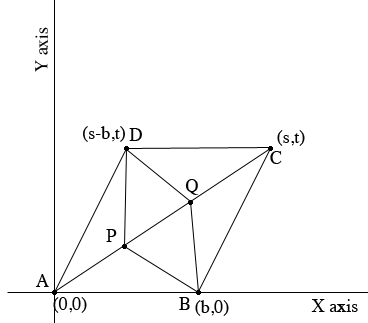| |||
| Math Central | Quandaries & Queries |
|
Question from Apollo: Prove analytically that if ABCD is a parallelogram in which points P and Q trisects the diagonal AC, then BPDQ is a parallelogram. |
Hi Apollo,
I drew a diagram in the Cartesian plane of what you described. I put $A$ at the origin, $B$ on the X-axis with coordinates (0,b), and $C$ at (s, t).

Since $AB$ is parallel to $CD,$ and $BC$ is parallel to $AD,$ you can determine the coordinates of $C$ and $D.$
What are the coordinates of $P$ and $Q?$
To show that $BPDQ$ is a parallelogram find the slopes of its four sides.
Penny
 |
||
Math Central is supported by the University of Regina and The Pacific Institute for the Mathematical Sciences.